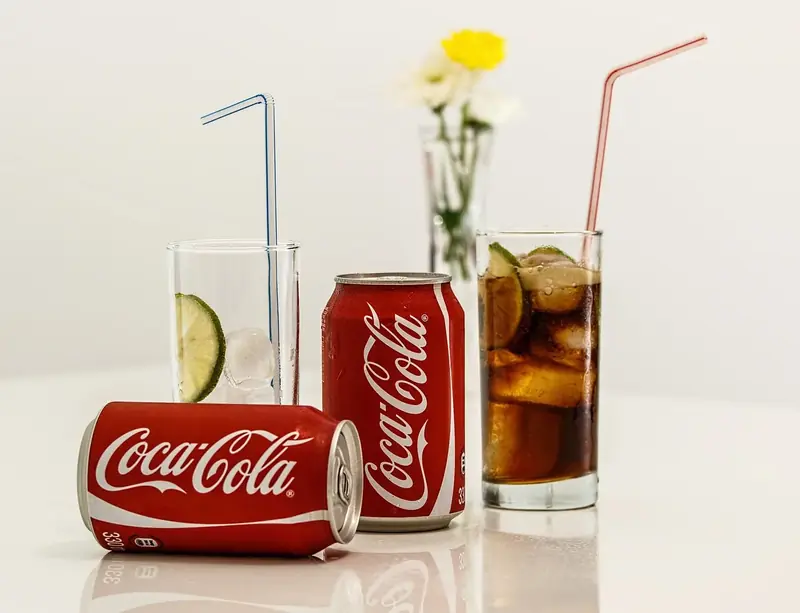
March 29 marks the birthday of Coca-Cola. The original medicinal concoction was created in 1886 by a drug-addicted pharmacist who died in poverty two years later. This drink, touted as a remedy for “any nervous disorders,” was made from extracts of three parts of the leaves of the South American coca plant (cocaine) and one part of the nuts from the kola tree (caffeine). The new remedy for headaches, hysteria, melancholy, and impotence was recommended for the elderly, and primarily prescribed to soldiers to treat morphine addiction, a condition the former front-line soldier was all too familiar with himself. At the largest pharmacy in Atlanta, this patented pharmaceutical product sold for 5 cents a glass and had limited demand. What changed the situation, and who created the national American brand Coca-Cola—the most recognized trademark in the world? What is Coca-Cola made from, which is sold in 200 countries, and when did this initially unprofitable drink bring success to the company that now sells about a billion units of its products every day?
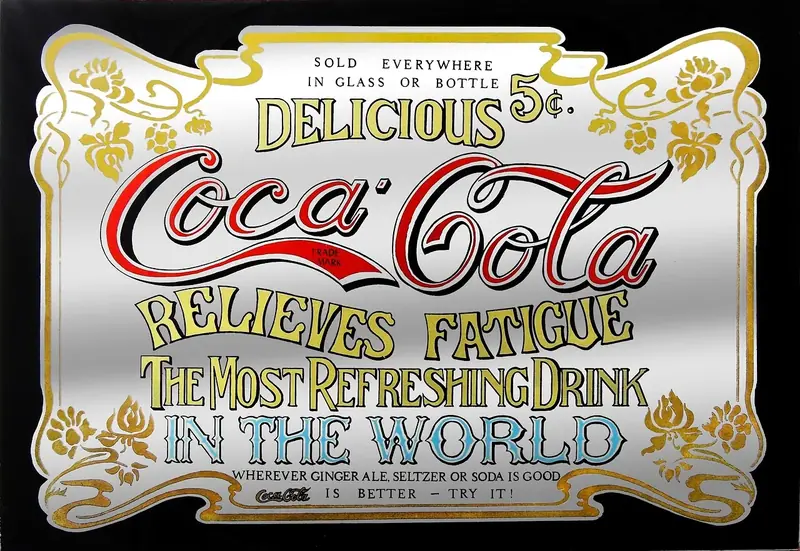
The Fate of the Recipe and Its Creator
The inventor of Coca-Cola was John Stith Pemberton (1831–1888), an American pharmacist and ophthalmologist with a military background. During the Civil War, he fought in the Confederate Army and rose to the rank of lieutenant colonel. After being wounded in 1865, he, like many other veterans, became addicted to morphine. In search of a cure for his addiction, the graduate of the University of Columbus School of Pharmacy began experimenting with coca (from which the narcotic component cocaine was isolated by chemist Albert Niemann in 1859) and created a precursor to “French Wine Coca,” known as Pemberton’s French Wine Coca.
After the introduction of Prohibition in Georgia in 1885, Pemberton had to remove the alcoholic component from the drink’s formula and replace it with a carbonated syrup made from burnt sugar. For this new variation, Frank Mason Robinson—Pemberton’s bookkeeper—coined the name Coca-Cola (which referenced the two main ingredients of the drink) and wrote it in the calligraphic letters we still see in the product’s logo today. The original formula contained 8.46 mg of cocaine from coca, while the caffeine from kola nuts enhanced the refreshing effect of the drink.
The first batch of the syrup, intended to treat morphine and opium addiction, was primarily directed at war veterans, encouraging addicts to switch to a less toxic alternative. Later, the product was recommended for treating neurasthenia, depression, impotence, stomach, intestinal, and kidney diseases. At Jacob’s largest pharmacy in Atlanta, the new medicine was sold from a fountain for 5 cents a glass, and initially, it was purchased by an average of 9 people a day. In its first year, the drink generated only $50 in sales, while $70 was spent on its production, meaning Coca-Cola was a loss-making product in its inaugural year. Its 57-year-old creator, John Pemberton, died in poverty from stomach cancer in 1888, and the rights to the drink were bought by the future founder of the company that still produces Coca-Cola.
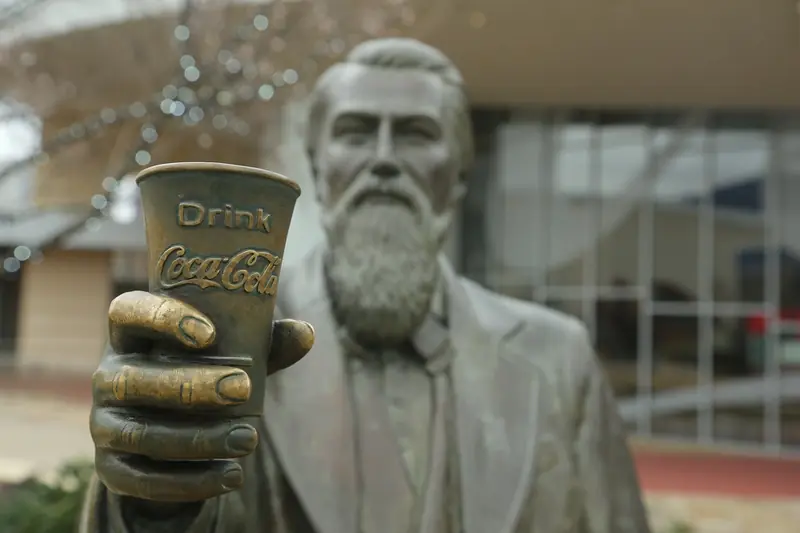
The History of Coca-Cola
The Coca-Cola Company was founded in 1892 by Asa Griggs Candler, a representative of the pharmacy business. A successful entrepreneur who began his career as a pharmacy owner, he came from a large family (one of eleven children of a prosperous merchant and plantation owner from Carroll County), was raised on Baptist ethics, and eventually donated millions to charity—his church, a hospital, and land for the construction of Emory University. Some believe that the recipe for Coca-Cola was sold to him by the inventor in the last year of his life. According to another version, the businessman purchased the rights to the drink for $2,300 from Pemberton’s widow. Candler began selling the product that would bring him great wealth in the U.S. in 1895, and by the following year, he and 50 employees were already distributing the drink in neighboring countries.
In 1899, the first Coca-Cola bottling franchise was established. In this model, which persisted throughout the 20th century, the main company focused on marketing and producing concentrates, from which independent manufacturers produced the drinks. Meanwhile, in 1916, over 150 lawsuits were filed against imitator brands like Fig Cola, Cold Cola, Candy Cola, Cay-Ola, and Koca Nola. Before leaving the company in 1917 to become the mayor of Atlanta, passing management of the business to his son Howard for two years and bequeathing 90% of the shares to family members, Asa Candler managed to make Coca-Cola the most famous drink in the U.S. By 1902, the company had already generated $120,000 in revenue.
However, by the late 1890s, the founder of The Coca-Cola Company had to respond to changing public opinion regarding cocaine. While it had not been banned (the health risks were not yet understood), perceptions of this ingredient in the drink began to shift. In 1903, a scathing article appeared in the New York Tribune, accusing Coca-Cola of causing attacks on white people by black individuals from urban slums who had consumed the narcotic drink. Due to this scandal, the legendary recipe had to be adjusted: from then on, Coca-Cola was produced not from fresh leaves but from pressed leaves from which cocaine had been removed. The drink’s popularity continued to rise. The first Coca-Cola billboard in Cartersville, Georgia, has stood in its place since 1904.
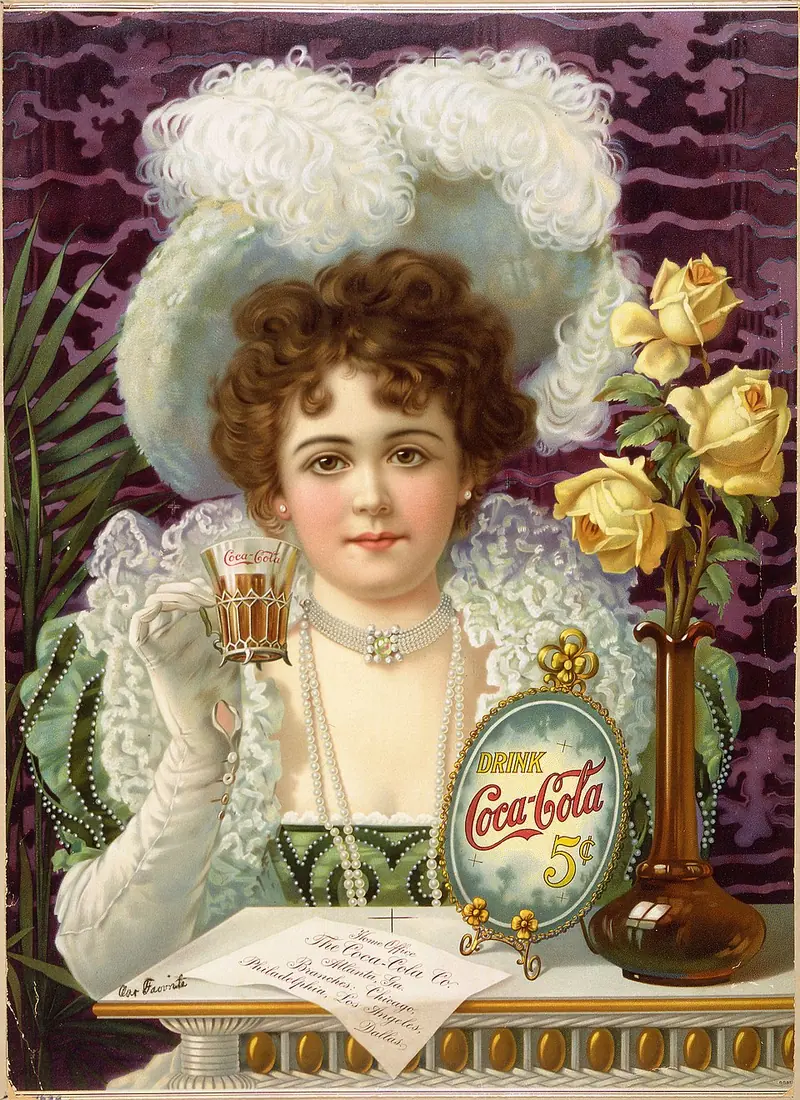
Coca-Cola advertisement, 1900
An American Icon
Since 1894, Coca-Cola has been bottled (it would not be sold in cans until much later—in 1955). In 1915, Indiana designer Earl R. Dean and his team developed a new 6.5-ounce bottle (an American ounce equals 30 ml). The design was inspired by the shape of a cocoa pod, as the designer, according to one theory, confused the meanings of the words coca and cocoa, and according to another, could not find any information about coca or kola in the library. In the following years, over 6 billion such bottles were produced. Starting in 1955, Coca-Cola was sold in bottles of 10, 12, and 26 ounces, and by the end of 2007, the company introduced a shorter glass bottle of 0.33 liters, significantly reducing carbon dioxide emissions during glass production.
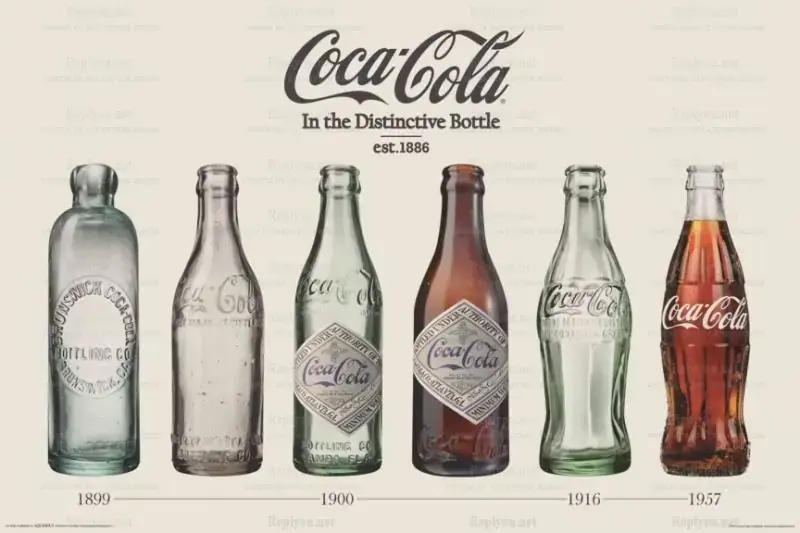
But this was already happening under new ownership of The Coca-Cola Company. In 1919, Howard Candler sold the family business for $25 million to a consortium led by Ernest Woodruff and Eugene Stetson. After the ownership change, the company became the largest public corporation in the food industry at that time: half a million shares were sold at $40 each. In 1943, Coca-Cola production facilities began operating in Europe and North Africa to boost the morale of American soldiers fighting there and to spread the drink worldwide. In 1990, Coca-Cola’s sales volume first surpassed $10 billion.
If all the Coca-Cola produced were distributed to the world’s population, each person would receive 1,500 bottles. Every second, 8,000 glasses of drinks produced by The Coca-Cola Company are consumed worldwide. In recent years, concentrate sales have accounted for 56% of its revenue, while finished products make up 44%. The primary region of the company’s operations remains the U.S.: currently, 36% of its revenue comes from its home country. Coca-Cola has become almost an icon for Americans and continues to hold its ground, leading the list of the most sought-after products in the soft drink market. Interestingly, the highest per capita consumption of Coca-Cola is found in such diverse countries as subtropical Mexico and polar Iceland.
The Company’s Secret
The demand for Coca-Cola remains strong, despite disapproval from doctors and dietitians regarding its consumption. Health professionals are concerned about the negative impact of this drink on the kidneys due to harmful ingredients—sugar and carbon dioxide. According to the official website, the classic version of Coca-Cola contains about 11% sugar, burnt sugar colorant E150, carbon dioxide, caffeine (140 ppm, or parts per million), orthophosphoric acid (with phosphorus content of 170 ppm), azorubine (a food additive from the dye group), and flavorings—vanillin, lemon oil, clove oil, and cinnamon oil. As we can see, the exact concentration of several ingredients is not disclosed. The proportions of Coca-Cola’s ingredients are a commercial secret, and revealing them is strictly prohibited.
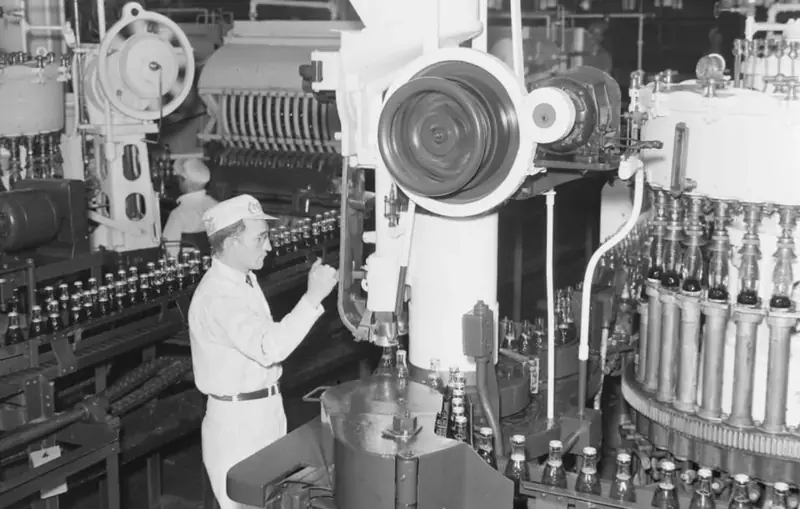
According to the company’s charter, only three responsible individuals can know the nuances of the formula at any given time. Companies that bottle drinks from the provided concentrates and syrups are allowed to make only minor variations to the Coca-Cola formula based on local raw material supplies. In 2009, during a court case at the insistence of Turkish authorities, it was revealed that among the food additives in the drink was also colorant E120 (carmine acid)—an extract from cochineal insects, specifically from the dried females of the Dactylopius coccus species. This news stirred public concern, as the consumption of insects is prohibited by some religions, including Judaism. In an official comment, the company denied the presence of carmine among its ingredients.
Unlike its composition, the caloric content of Coca-Cola is not a secret: its energy value is 42 kcal, and the carbohydrate content is 10.6 g per 100 g of the product. As early as 1982, Coca-Cola producers began releasing a diet version, Diet Coke, and later, under pressure from competitors, they started supplying sugar-free and caffeine-free drinks to the market. The Coca-Cola range expanded to include varieties with minimal carbohydrates. Coca-Cola Light has a familiar taste but contains only 0.3 calories per 0.1 liters. Meanwhile, Zero drinks (Coca-Cola Zero Lemon, Coca-Cola Zero Lime, Coca-Cola Zero Orange, Coca-Cola Zero Vanilla) contain no sugar, making them nearly calorie-free (only 0.2 kcal). But does the absence of sugar reduce the risk of obesity, and how do its synthetic substitutes affect the body?

The Benefits and Harms of Coca-Cola
Among the artificial sweeteners in the non-alcoholic soda Cola Zero is aspartame, which is a potential carcinogen. In addition to increasing the risk of cancer and metabolic syndrome, aspartame affects brain health: phenylalanine in its compounds can cause headaches and even trigger epileptic seizures. Cola Zero also contains other synthetic sweeteners—potassium acesulfame and sodium cyclamate. These components not only stimulate appetite but also create cravings for fatty foods, so regular consumption of “zero” Coca-Cola can lead to weight gain. Studies have shown that artificially sweetened sodas provoke obesity, type 2 diabetes, and an increased risk of premature death due to elevated blood pressure.
Consumption of sodas with artificial sugar substitutes has been linked to a 28% increase in the risk of liver cancer. Carbon dioxide in the soda can adversely affect the liver and gallbladder and cause heartburn. Coca-Cola is not recommended for individuals with bile duct disorders and gastrointestinal diseases, specifically acute or chronic gastritis, increased gastric secretion, and peptic ulcers of the stomach and duodenum. Phosphoric acid in Coca-Cola contributes to kidney stone formation, erodes tooth enamel, and can harm teeth. This component inhibits the absorption of calcium, which is necessary for bone formation, so Coca-Cola should not be consumed by children and teenagers who are still growing.
Individuals with diabetes should be mindful of the high sugar content in the classic recipe, which raises blood sugar levels. Additionally, caffeine in Coca-Cola increases heart rate and breathing. At the same time, the drink, known for its stimulating and refreshing effects, invigorates the brain, alleviates fatigue and drowsiness, stops nausea and diarrhea, and soothes pain (including stomach pain). Thus, the drink with plant extracts is valued not only for its unique taste. To avoid disrupting metabolism and gaining weight, it’s important to be aware of how much Coca-Cola one can safely consume in a day. A periodically consumed 0.33-liter can is considered safe for health when accompanied by a healthy diet and lifestyle overall.
In Sweet Captivity
Regular overconsumption of this stimulating drink can lead to insomnia. If Coca-Cola is consumed for 4-5 consecutive days, it can create a dependency, where sudden cessation leads to withdrawal symptoms such as irritability and drowsiness. Symptoms of withdrawal can last one to two days after the last consumption of Coca-Cola. Restoring normal well-being can be achieved by consuming the same drink that caused the condition. This is why people quickly “get hooked” if they do not control their intake. To ensure that Coca-Cola only has a beneficial effect on the body and does not cause unwanted consequences, it should be consumed only occasionally and in moderation. Otherwise, the drink will claim another victim, which is advantageous for the manufacturer.
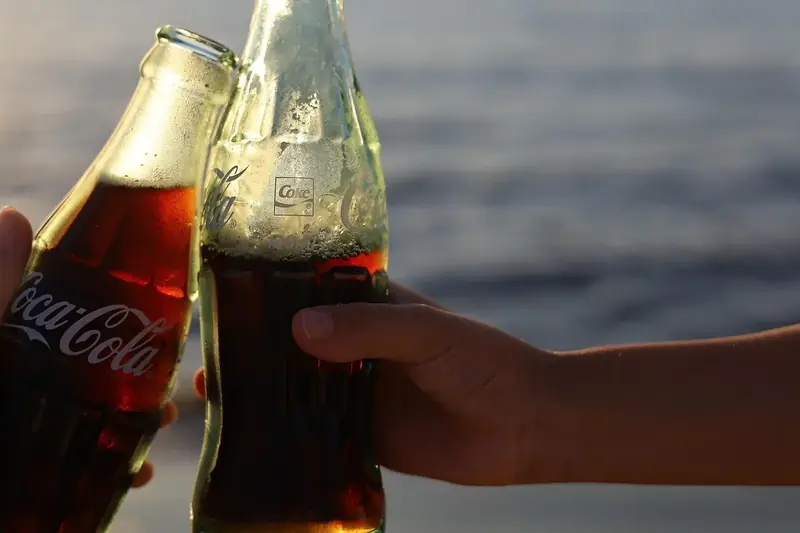
As early as 1909, English science fiction writer Herbert Wells wrote a realistic novel, Tono-Bungay, which satirized the story of Coca-Cola—depicting the creation, advertising, and distribution of a drink called “tono-benge.” In the plot, a young scientist helps promote harmful stimulants disguised as miraculous universal medicines created and patented by his ambitious uncle. The rising sales of “tono-benge” rapidly elevate the hero’s social status, bringing him wealth he could only dream of. In reality, all the Coca-Cola produced could fill a pool 1.8 meters deep and measuring 33 by 15 kilometers—enough space for 512 million people to enter simultaneously.
In 2004, The Coca-Cola Company received the Ig Nobel Prize in Chemistry “for turning water into a substance unsuitable for drinking.” Among the reports of Coca-Cola’s “miraculous” properties, there is information that it is used for washing heavily soiled items, cleaning glass, scrubbing toilets, and removing rust. Indian farmers reportedly replace pesticides with this drink, spraying it on spice plantations and cotton fields to eliminate pests. Allegedly, the Chinese even tested Coca-Cola as a contraceptive. There are many sensational stories associated with this drink, so the endless curiosity about Coca-Cola only confirms its legendary status.

